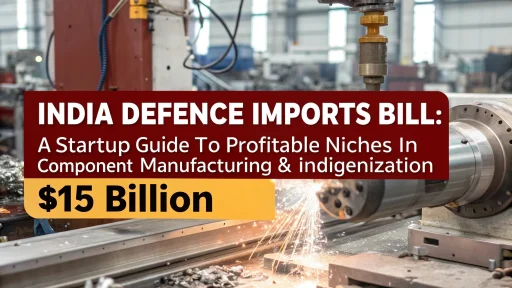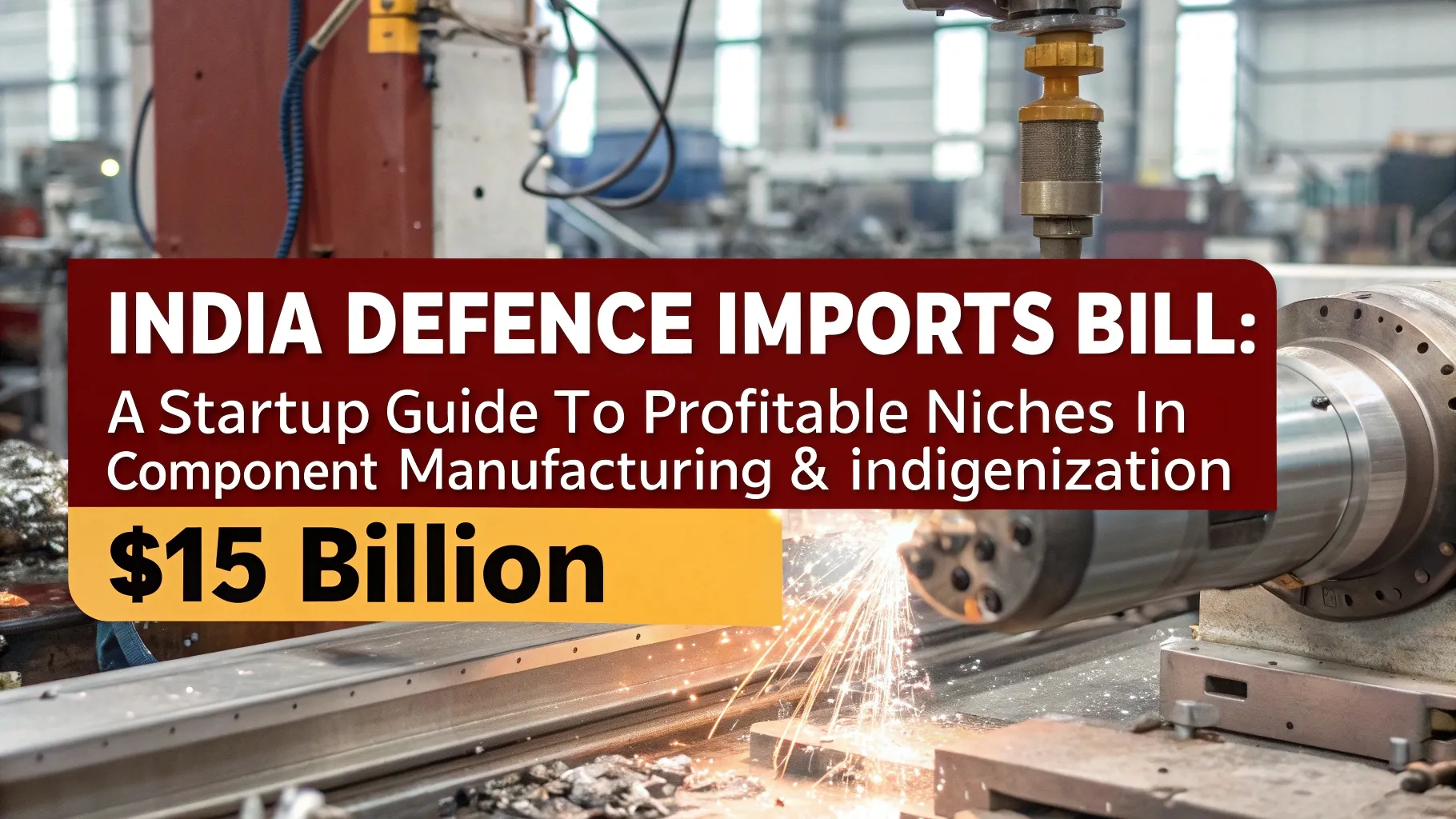From Dependency to Industrial Revival
One of the top India Defence Imports equipment in the world. India’s $15 billion+ annual reliance on foreign OEMs drains economic resources and undermines strategic autonomy. Despite domestic successes like the LCA Tejas and Arjun tank, India still depends on foreign‑sourced avionics, turbine parts, communication modules, and sensors.
That dependency, however, is being swiftly challenged.
India is undergoing an alteration in the way its defense requirements are fulfilled, thanks to strong policy changes through the “Atmanirbhar Bharat” initiative. The government is prioritizing localization in defense manufacturing. This push extends beyond full systems to include critical subassemblies, high‑precision components, and core materials. Startups and MSMEs can seize major opportunities by becoming core suppliers—rather than just junior partners—in the defense ecosystem.
The defense industrial sector is unique because it combines long product lifecycles with sustained demand. It also drives technology spillovers and benefits from preferential purchase policies for domestic suppliers. These factors create openings for entrepreneurs with knowledge in machining, electronics, materials science, optics, and precision systems.
Defining the Opportunity: India’s Major Areas of Importation
To measure the true potential of the opportunities available, it is necessary to determine India’s areas of import dependency. India is one of the world’s largest consumers of weapon systems. However, a significant portion of defense imports includes modules, components, and subsystems. Most of these are within the reach of competent startups to manufacture utilizing the infrastructure present.
The following comprise the defense imports profile for India:
- Turbine blades, nozzles, and actuators for aircraft engines.
- High-frequency radars, printed circuit boards (PCBs), and RF modules for avionics.
- Gearboxes, heat exchangers, and transmission systems for tanks and armored vehicles.
- Sonar arrays, control valves, and propulsion components for naval ships and submarines.
- Optical sights, lenses, and fire-control computers for small arms and artillery.
Although these components are small, they possess a high value. Such small parts undergo manufacturing processes in India which involve stringent tolerances and coatings. Despite being possible to manufacture here, they are still imported due to a lack of perceived risk or vendor base.
Specializing in components lets Indian startups address domestic defense needs. It also opens doors to partner with global OEMs via co-development and offset agreements.
Related: Top 20 Chemical Imports to India in 2025: A Strategic Guide for Entrepreneurs and Startups
Analyzing the Component Ecosystem: Overview by Sectors
Aerospace and Aircraft Components
Key platforms—UAVs, helicopters, and fighter jets—still depend heavily on imported parts. Despite DRDO’s homegrown systems, critical components like actuators, engine blades, fuel injectors, and gears come from the US, France, or Russia.
These parts require stringent processes such as heat treatment and high-precision machining using aerospace materials including titanium and Inconel alloys. Many of these components can be manufactured in India through supplier agreements with DRDO or HAL. Startups can tap into this opportunity by investing in five-axis machining, advanced metallurgy, or CNC-based fabrication.
Avionics and Defence Electronics
One of the most neglected areas is the electronics and embedded systems technology for defense. Radar systems, communication devices, surveillance drones, and missile guidance systems require precision PCBs and advanced control processors. They also depend on high‑capacity memory modules, GPS units, and RF antennas. India continues to rely on countries like Israel and France for high-frequency RF modules and EW (Electronic Warfare) systems.
The domestic electronics manufacturing ecosystem—currently oriented toward consumer and telecom—can be retooled toward military-grade specifications.
Naval and Submarine Systems
Apart from these, regional ships and submarines have tangible needs for component manufacture. Many components such as propeller shafts, sonar sensor housings, fire control wiring, underwater seals, and power converters for both ships and submarines are still not widely produced and are thus restricted to public-sector yards.
Small manufacturers are increasingly welcomed into modern shipbuilding for modular systems, where bigger shipyards need smaller parts or units. Startups in metal forging, pressure vessel design, thermal coatings, or underwater electronics for defense can seamlessly integrate into this supply chain. Besides, there is sustained growth potential in the family of products created to meet the growing demand for indigenous aircraft carriers and advanced diesel submarines.
Land Systems and Armoured Vehicles
Optical periscopes and ceramic armor panels, as well as electronic fire control systems and turret stabilizers, are components utilized by tanks, infantry vehicles, mobile artillery, and missile launchers.
There is an opening for precision metalworks, optics manufacturing, and embedded computing startups in the Arjun Tank upgrades and Future Infantry Combat Vehicles (FICV) issues by Indian Army’s modernization plans for their armored fleet.
Related: List of Products Manufactured by Indian MSMEs in Defence Sector
The Dual-Use Advantage: Serving Civilian and Defence Markets
Entering the defence market comes with the unique benefit of many parts sharing the dual-use advantage. While items designed for defense purposes often seamlessly integrate into civilian counterparts, it works in reverse as well. For example:
- Wildlife monitoring and perimeter security can employ thermal imaging cameras originally designed for night vision.
- Industrial automation and space technology can utilize ruggedized electronics and GPS modules created for tanks and aircraft.
- The aerospace and sports industries are able to use carbon-fiber components made for UAVs.
Defence startups that offer modular designs marked with defence-grade specs but versatile uses stand to earn profits from civilian markets. This approach decreases business risk and improves asset efficiency.
Organizational Policies Along With Motivating Factors For Startups
India’s defense sector policies have been increasingly accommodating towards private startups and are providing a supportive ecosystem for entrepreneurs. In the last five years, the Ministry of Defence has rolled out interlinked schemes aimed at fostering self-reliance while encouraging innovation and homegrown capability.
The Defence Acquisition Procedure (DAP) has now incorporated minimum Indian participation clauses for military contracts. Additionally, the ‘Positive Indigenization List’ prevents the import of several components like radio modules, brake systems, and even certain filters and telescopic sights, which ensures that there is a market for these products to be manufactured domestically.
With iDEX (Innovations for Defence Excellence) and iDEx (Defense Innovations for Excellence) programs, as well as the Technology Development Fund (TDF), the structure provides equity funding, guidance, and pilot projects in collaboration with DRDO labs and military users. Even foreign OEMs under offset obligations have incentives to procure from Indian startups and are allowed to do so through joint ventures, licenses, or co-manufacturing.
Obstacles in Defense Manufacturing and the Role of Startups in Overcoming Them
The sector possesses a unique set of opportunities, but it does come with a few challenges. Every startup is familiar with the difficulties a lack of certification brings. For instance, environmental and quality review protocols are stringent for defense components. For compliance, startups will need to invest in testing and evaluation infrastructure due to the mandatory military standards, AS9100, and AQAP.
In addition to that, the procurement cycles are often lengthy. As seen in other sectors, the decision-making timeframe tends to drag on within the defense PSUs and procurement boards. Finances in the form of investment will need to be allocated until revenue starts streaming in, especially due to the prolonged lead time.
From an engineering perspective, standard product replication is often impossible. Most systems will require varying degrees of custom engineering, necessitating tailored design iterations and rigorous testing for each component or assembly. Collaborating with defense research facilities and engineering institutes will ease the need for strong R&D partnerships.
Even while these challenges exist, they are all possible to tackle. Startups refining their capabilities by starting from subcomponent-level manufacturing and proving their demonstrated quality over time will help them earn the ability to co-develop complex modules.
For more information check out our related video
How NPCS Supports Entrepreneurs in Defence Component Manufacturing
Establishing a manufacturing unit in the defence sector involves navigating technical, legal, and operational complexities.
Niir Project Consultancy Services (NPCS) plays a vital role in this process by equipping entrepreneurs with comprehensive tools to plan and execute industrial setups.
NPCS provides:
- Detailed Techno-Economic Feasibility Reports with sector-specific market intelligence.
- Full documentation on raw materials, manufacturing process, plant layout, and output configuration.
- Expert guidance to assess project viability and regulatory preparedness in the defence and engineering sectors.
Whether it’s small-scale PCB assembly or setting up a precision machining unit, NPCS offers a practical roadmap for entrepreneurs ready to serve the nation’s growing defence needs.
Which business to start? How to choose a business idea?
Conclusion: Building the Future, One Component at a Time
$15 billion India Defence Imports bill is not a gap—it’s an industrial opportunity waiting to be tapped. As the country transitions from buyer to builder, the future of self-reliance will not be built solely by megaprojects or large defence conglomerates. It will be shaped by thousands of agile, high-precision startups that manufacture the unseen but indispensable components of a sovereign defence ecosystem.
By entering this sector, entrepreneurs are not just building profitable ventures—they are contributing to the very fabric of national security. For those with the ambition, discipline, and technical acumen, this isn’t just a sector—it’s a mission.







